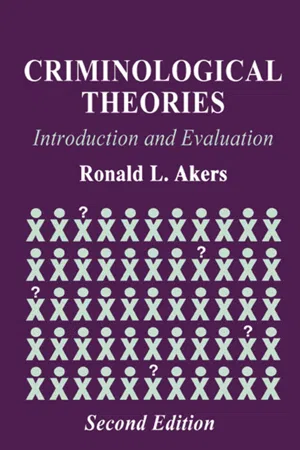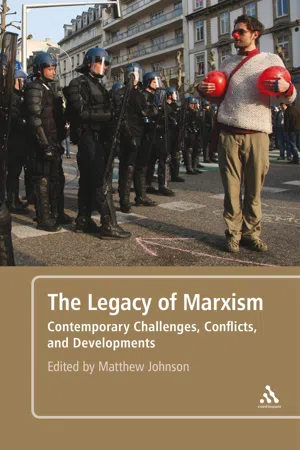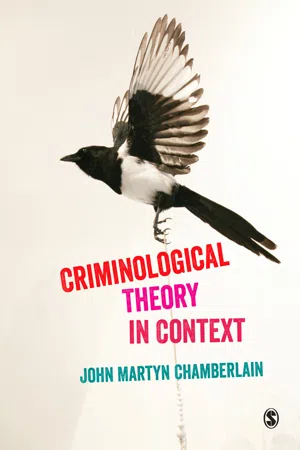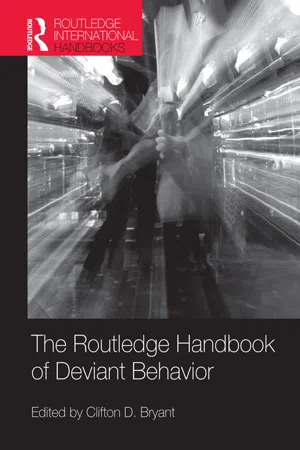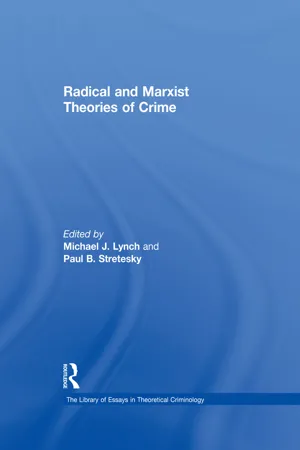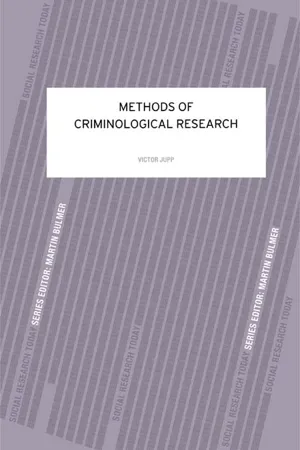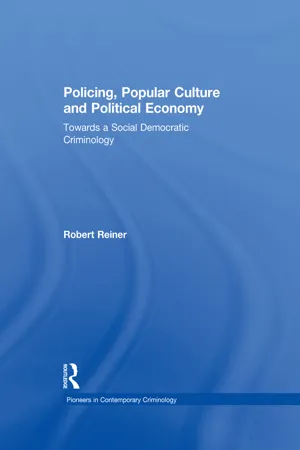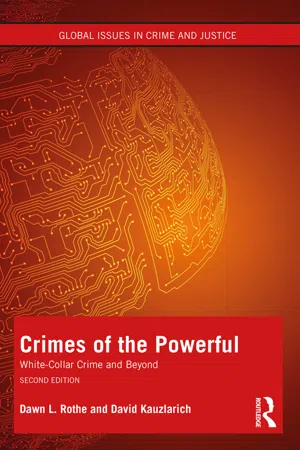Social Sciences
Marxist Theories of Crime
Marxist theories of crime focus on the relationship between crime and the structure of society. They argue that crime is a product of the unequal distribution of wealth and power in capitalist societies. According to Marxists, crime is a result of the economic and social conditions that lead individuals to commit criminal acts as a response to their marginalized position in society.
Written by Perlego with AI-assistance
Related key terms
9 Key excerpts on "Marxist Theories of Crime"
- eBook - ePub
Criminological Theories
Introduction and Evaluation
- Ronald L. Akers(Author)
- 2013(Publication Date)
- Routledge(Publisher)
As these examples demonstrate, when Marxist theorists offer explanations of crime that go beyond simply attributing the causes of all crime to capitalism, they rely on concepts taken directly from the same “traditional” criminological theories of which they have been so critical and which they have declared to be inadequate. As Jensen (1980) points out, the specific factors used in modified Marxist theories to explain crime, such as economic and racial inequality, urban density, industrialization, family, and peers, are exactly the same factors proposed in mainstream, non-Marxist sociological theories. The more Marxist theory in criminology is modified to incorporate age, gender, socialization, strain, differential opportunity, and social learning patterns, the less it differs from non-Marxist theories. Except for nuances of emphasis and terminology, it becomes virtually indistinguishable from the main sociological theories of crime that it was meant to replace.Is Crime the Result of a Capitalist Economy?
If the Marxist view of capitalist society as criminogenic is valid, then crime should be very low, if not non-existent, in all socialist societies. Conversely, it should be very high in all capitalist systems. The theory explains differences in the crime rate across types of society, but it does not explain differences in individual or group behavior within the same society. Therefore, any analysis of variations in crime solely within the same society cannot test the theory. The inherent, crime-generating contradictions of capitalism can only be tested by cross-national comparisons of crime in capitalist systems with crime in pre-capitalist and socialist systems.2Marxist criminologists have shown little interest in such comparisons of real societies, preferring to compare existing capitalist society with ideal, future socialist systems. Many Marxists have long argued that none of the currently defunct socialist states of the Soviet Union and eastern Europe were truly socialist. These systems were state capitalism, collectivism, or at best imperfectly and improperly applied socialism (see Greenberg, 1981). During the time that countries such as Sweden moved from more capitalistic economies and voted in social democratic governments with policies that are often described as socialist, both violent and property crime rates have skyrocketed (Felson, 1994:12). But Marxists would not accept the political economy of these societies as truly socialist. This concept of socialist society as a future Utopia that has yet to be established in reality renders Marxist theory untestable. If no such society based on Marxist principles exists or has ever existed, then there can be no empirical comparison of crime between capitalist and socialist systems; hence, it would be impossible to test the Marxist hypothesis that capitalism causes crime and socialism prevents crime. Such utopianism changes Marxism from a theoretical explanation of crime as it exists in reality into a moral philosophy about a crime-free ideal society. - eBook - ePub
The Legacy of Marxism
Contemporary Challenges, Conflicts, and Developments
- Matthew Johnson(Author)
- 2012(Publication Date)
- Continuum(Publisher)
CHAPTER EIGHT Can Marxism make sense of crime? Mark Cowling IntroductionThe aim of this chapter is to present an overview of the obvious possibilities in using Marxism to make sense of criminological theory. A brief explanation for non-criminologists: criminological theory typically comprises one central part of criminology degrees, the other central part comprises an account of the criminal justice system. Criminological theory looks at theories which purport to explain what is crime and why people commit it. The rest of this introduction discusses issues involved in identifying crime. The main substance of this chapter is a discussion of a series of ways in which Marxism as a social theory might be used in order to make sense of crime. The sections of the chapter correspond to the possibilities I consider: the idea of the lumpenproletariat as the criminal class; possible links between the theory of alienation and crime; crime or the criminal justice system as a reproduction condition of capitalism; the Marxist account of law as the basis for making sense of crime; an analysis based on a Marxist account of distributive justice but linked to an account of criminal justice; and finally the question of whether crime would disappear under communism.The identification of crime is quite a complicated issue. Typical dictionary definitions refer on the one hand to an act punishable by law and on the other to an act which causes serious harm. It takes only a moment’s thought to recognize that these are by no means always fully aligned. At minimum, victimless crimes such as those associated with prostitution and the imbibing of drugs should perhaps be decriminalized, and various activities which are currently not treated as criminal should perhaps be made illegal. A notable example of a crime which is not effectively prosecuted under English law is the war crime of invading other countries without just cause, which is much more harmful than the low-level street crime recorded by the Home Office. The concept of crime is notoriously slippery because crimes come and go: damaging Westminster Bridge and pretending to be a Chelsea pensioner are no longer capital offences. This leads many criminologists, but particularly those on the left, to argue that ‘crime has no ontological reality’. They use examples such as that killing people in time of war can be seen as commendable, or that rape within marriage was legal until 1991 in England to claim that pretty much anything can be criminalized or de-criminalized. Marx, Engels and Bonger are then accused of excessive reliance on official statistics. Although I am generally sympathetic to many of the projects and claims of left-wing criminologists, I do not accept this claim. Instead I prefer the idea of a pyramid of crime (see Hagan 1994: 12) in which murder, robbery and rape are deemed basically criminal in pretty much any society. A society in which these were fully decriminalized would be one where life is nasty, brutish and short. As you go down, the pyramid matters become more flexible. The most flexible crimes are those based on paternalism, morality and religion. Even below this come activities that are legal, but generally seen as inappropriate, such as making romantic gestures to your mother-in-law. It is certainly possible to go in the opposite direction from general decriminalization and criminalize virtually anything. Life under the Taliban would be a good illustration of this. Television, alcohol, pork, homosexuality, sex outside marriage, education for women, going out in public unless dressed in a burka and accompanied by a male relative for women, shaving for men were all made illegal, so that all the main forms of entertainment in advanced Western societies were not permitted. - eBook - ePub
Criminological Theory in Context
An Introduction
- John Martyn Chamberlain(Author)
- 2015(Publication Date)
- SAGE Publications Ltd(Publisher)
Marxist criminology was also heavily criticised for holding, firstly, an overly deterministic view of human behaviour and the ability of human beings to exercise free will and change both their behaviour and their circumstances, and secondly, an overly romantic view of the working-class criminal and having a concurrent tendency to excuse their behaviour on the grounds of the fact that they are exploited by a ruling elite (Coleman et al., 2009). Furthermore, it is generally held by later Critical criminologists that Marxist criminology oversimplifies society into essentially two groups of ‘have’s’ and ‘have-not’s’, not least of all because the idea that a small band of powerful people, who are in collusion with each other, somehow run society and determine the destinies of us all is rather wide of the mark and arguably somewhat the stuff of bad Hollywood movies. It is important to remember here the key position of the conflict paradigm: that society is made up of a number of competing groups operating in conflict with each other, not just two. Finally, another key criticism of Marxist criminology is that its proponents seemed to argue that a Critical socialist revolution is the only solution to society’s many social problems, including crime. Yet more pragmatic criminologists pointed out that this oversimplified matters and that they would probably achieve more lasting social change from working with the existing system and making incremental changes within it.Box 6.3 Key summary points
- Influenced by the work of Marx and Bonger, a key idea running through the emergence of Critical Marxist forms of criminology in the late 1960s and early 1970s was that most crime is a rational means of survival when survival is never guaranteed due to the inherent conflicts and class divisions which exist within capitalist societies. In his book Class, state and crime Richard Quinney (1979: 176) writes that ‘much criminal behaviour is of a parasitical nature, including burglary, robbery, drug dealing, and hustling of various sorts’.
- Marxist criminologists view crime and deviance as social constructs, rather than as things which somehow belong to individuals as a result of some aspect of their individual biology or psychology.
- Marxist criminologists argued that by divorcing the study of crime from the study of class domination criminologists are tacitly involved in reproducing the inequalities caused by capitalism. They are challenging the idea that criminology can be a disinterested social science and conclude that criminologists must not simply look at the law breakers, but the law makers and law keepers as well.
- Marxist criminology was criticised for possessing an overly deterministic view of human behaviour and an over-romantic view of the working-class criminal. It was also criticised by Critical and Feminist criminologists who argued that certain crimes involving female victims and victims from ethnic minorities, including forms of hate crime, rape and domestic violence, are due to ideological factors relating to patriarchy or institutionalised forms of racism, rather than responses to the class-based inequality caused by capitalist systems.
- eBook - ePub
- Clifton D. Bryant(Author)
- 2012(Publication Date)
- Routledge(Publisher)
An important concept is that of surplus population, in that much of the existing forms of criminalisation and public concern with street crime are seen to be targeted at those layers or sections of the population that are surplus to the labour market and the requirements of capitalism generally (Spitzer, 1975). A broad political economic analysis of capitalism is needed in order to set the scene for research and writing on more specific aspects of class conflict and class processes relating to crime, such as youth subcultures (see Hall and Jefferson, 1976). The ongoing contribution of a Marxist framework to understanding contemporary developments in society, and criminal justice specifically, has long been highlighted in the work and writings of Jeffrey Reiman (1998). Reiman first published The Rich Get Richer and the Poor Get Prison in 1979. As the title suggests, this book is an analysis of the economic biases, ideological processes, and social inequalities associated with the criminal justice system. In later editions, the book includes an appendix that provides a detailed outline of the Marxist critique of criminal justice. Marxism as an analytical framework may have declined in popularity among academic intellectuals, but Reiman (1999) argues that the issues with which it is concerned have not lost any of their potency or relevance. The Marxist criminological approach highlights the inequalities of a class society (for example, wealth versus poverty, business profits versus low wages), and the impact these have on the criminalisation process. The powerful are seen as designing the laws in their own collective interest, while having greater capacity to defend themselves individually if they do break and bend existing rules and regulations. The less powerful in society are seen as propelled to commit crime through economic need and social alienation - eBook - ePub
- Cowburn, Malcolm, Duggan, Marian(Authors)
- 2015(Publication Date)
- Policy Press(Publisher)
11 and there is nothing inherent in its formulation that prevents its articulation with other theories, themes and ideas in the criminological canon. This is important, for, as Tierney (2010, pp 334–5) suggests, fragmentation and cross-fertilisation are emblematic of contemporary criminological theory; ‘self contained theoretical clusters’ are increasingly rare. Today, ‘critical’ criminology ‘is characterised by degrees of diversity and fragmentation, partly resulting from the dissolution of its explicit links with Marxist social theory’ (Tierney, 2010, p 361). Yet, Marxist traces and echoes can be seen in the work of critical criminologists who are not expressly Marxist in orientation, such as left realists, cultural criminologists, feminist criminologists, green criminologists and theorists of punishment, globalisation, white-collar and corporate crime, and moral panics and the media. As Downes and Rock (2007, p 324) argue: ‘it is more difficult than in the past … to see where Marxism begins and ends’. Petty, dogmatic, self-imposed factionalism is clearly self-defeating in such a context.Such factionalism is even more nonsensical when, as Roemer (1988, p 124) suggests, the central thrust of Marxist theory is now widely adopted by social theorists of all hues: ‘it is questionable what it means to take a specifically Marxist approach to history when the materialist axiom, the cornerstone of the Marxist approach, has become central to almost all contemporary social thought’. Indeed, as Elster (1986, p 5) argues, there is an inevitable paradox that Marxism, like any theory, must face: if it is not plausible, then it will simply disappear, but if it is plausible, then it is likely to be subsumed into the mainstream of social science and cease to be specifically Marxist. As such, the decline of explicitly Marxist work in critical criminology is, in one sense, a result of the fundamental theoretical plausibility of the materialist perspective.12Conclusion: the persistence of Becker’s questions
It is clear that Marxism has immense difficulty in providing robust answers to the questions raised by Becker. The erosion of the traditionally conceived classes of modernity has made it increasingly difficult for Marxists to specify whose side they are on, and the contradictions inherent in the theory itself make the espousal of particular values a daunting and divisive task. An adoption of the censure perspective not only offers Marxist criminology a productive way forward, but also renders Becker’s questions of less immediate importance. - eBook - ePub
- Paul B. Stretesky, Michael J. Lynch(Authors)
- 2017(Publication Date)
- Routledge(Publisher)
IntroductionRadical or Marxist criminology (hereafter RMC), also identified by other labels - for example socialist, neo-Marxist, leftist, criminologies of the left (Lynch and Michalowski, 2006) emerged as a criminological area of interest during the late 1960s and early 1970s, although its roots can be traced back to some classic works, particularly Engels' The Condition of the Working Class in England (1845), Bonger's Criminality' and Economic Conditions (1905) and Rusche and Kirchheimer's Punishment and Social Structure (1939). This introduction provides a brief description of RMC and its important theoretical and empirical developments.At the heart of modem Marxist political economic theory is a concern for the causes and consequences of class structure and formation (Wright, 1997). As Wright notes, "[t]he concept of class figures as an explanatory principle ... in virtually all substantive problems addressed within Marxist theory' (1997, p. 27). As such, RMC focuses on the relationship between crime, class structure and class formation and has examined the ways in which social class shapes (1) the definition of crime (Schwendinger and Schwendinger, 1970, 1972 and Chapter 1 in this volume); (2) the formation and content of law (Tigar, 1977); (3) criminal justice processes (Chambliss and Seidman, 1982; Chambliss, 1999; Quinney, 1974; Reiman, 2006), including policing (Hall et al., 1978; Harring, 1983; Platt et al., 1982), imprisonment (Reiman, 2006) and courts (Hay et al., 1975); and (4) how class inequalities relate to the causes of various crimes such as serious juvenile delinquency (Colvin and Pauly, Chapter 15 in this volume), corporate crime (Box, 1984) and crime more generally (Taylor et al., 1973). Given the wide range of RMC we broadly define it as an approach that employs class analysis and Marxist political economic theory to address an array of concerns relevant to the study of crime, including law, justice and social control (Spitzer, Chapter 6 - eBook - ePub
- Victor R Jupp(Author)
- 2012(Publication Date)
- Routledge(Publisher)
However, it was argued that whilst a concern with everyday life and social interactions was important, this was not by itself sufficient since adequate attention was not being paid to differential power relations in such interactions, nor to the origins of such power relations in structural—particularly class—divisions and conflicts. In doing this, Taylor, Walton and Young sought to create a theoretical approach which would link interactionist theories and Marxist concerns with historical processes and structural arrangements (although no major empirical work emerged out of this development with the exceptions of Pearce, 1976, and Hall et al., 1978). Radical theory was not only developed to explain crime (that is, why certain categories of individuals commit crimes) but also crime control and criminalization (how and why certain categories of individuals are criminalized by laws and their enforcement). In the latter, the role of the state and its crime-control operators (including, incidentally, its crime-research apparatus) is important in so far as the state is viewed as a mere agent of the propertied class. Within this framework, official data reflect patterns of crime and also patterns of criminalization as structurally induced. Statistics are not viewed as the composite of a wide range of everyday interactions and therefore without pattern but as the outcome of class relations in society at any given time - eBook - ePub
Policing, Popular Culture and Political Economy
Towards a Social Democratic Criminology
- Robert Reiner(Author)
- 2017(Publication Date)
- Routledge(Publisher)
Above all it cannot readily or plausibly interpret laws which on the face of it operate to control members of the ruling-class or to advance the welfare of the working-class. Nor can it explain why there is clear cross-class consensus about the most central aspects of criminal law and criminal justice (Levi, 1987, Ch. 3). A reading of Marx on the origins of the Factory Acts in Capital (Vol. 1, Ch. 10) shows clearly that Marx's own analysis of the relationship between class, law and state was not an instrumentalist one. The reaction to the perceived inadequacies of instrumentalism amongst many Marxist criminologists was "back to the classics". Nor so much to Marx himself because of the lack of an elaborated theory of law and the state in his mature work, as to later Marxist theorists. Thus in the joint National Deviancy Conference/Conference of Socialist Economists' 1979 Capitalism and the Rule of Law: From Deviancy Theory to Marxism, there are papers exploring the possibilities of such early twentieth century Marxists as Renner or Pashukanis. The apogee of the attempt to develop an analysis of law, crime and the state within the Marxist tradition is the ambitious and complex 1978 book Policing the Crisis by Stuart Hall et al. This is an impressive marriage of concepts derived from "new" deviance theory (moral panic, folk-devils, deviance amplification, labelling) with modern Marxist theory of the state, particularly as developed by Gramsci, Althusser and Poulantzas. Starting with the analysis of the "mugging" scare of 1972-3 (and in particular one particular robbery in Handsworth in 1972), the authors "go behind the label to the contradictory social content which is mystifyingly reflected in it" (Hall et al., 1978, vii). From the study of the "mugging" panic the authors are led to analyse "the general 'crisis of hegemony' in the Britain of the 1970s" - eBook - ePub
Crimes of the Powerful
White-Collar Crime and Beyond
- Dawn Rothe, David Kauzlarich(Authors)
- 2022(Publication Date)
- Routledge(Publisher)
Theory integration combines two or more existing theories, concepts, and/or propositions that are closely related or are considered competing theoretical models into one more comprehensive model. It can take several forms: it can be specific or general, propositional or conceptual, static or dynamic (Liska, Krohn, and Messner 1989; Barak 1997). There is also side-by-side integration, which involves combining partial theories to explain a phenomenon, or end-to-end integration, which entails shuffling variables from one theory to another, making the dependent variable independent and vice versa. An up-and-down integration is the development of a “general” theory that includes multiple propositions from specific theories. Integrated macro-micro theories “focus on both the individual and the structure plus on some kind of interaction between the two” (Barak 1997: 198). Integration can combine single-level or multilevel analyses as well as intradisciplinary or interdisciplinary critique. Our approach in this chapter is an interdisciplinary multilevel approach. As Jack Douglas (1977: 51) stated, far too often we are guilty of “‘simplificationism’: the modern scientists’ self-imposed professional myopia, the insistence of each specialist on seeing everything as caused by the few particular variables he happens to ‘own’ professionally.” A theoretical framework should recognize the diversity and dialectic aspects of international (when applicable), macro, meso, and micro issues and the totality of the system within which all of these are produced and reproduced. So what would such a theory look like? Which disciplines’ theoretical perspectives should be included?Criminology and Beyond
Let us begin by saying that though we have pointed out the limited utility of criminological theories for explaining crimes of the powerful (as well as street crime), we suggest that in an integrated fashion, some criminological theories aid in our understanding. To ignore extant theory is to be forced to reinvent the wheel, and such a posture is not only myopic in that it ignores decades of established theorizing and theory testing, but it is arrogant in its rejection of what has come before. Over the course of the past few decades several criminological theories have aided in analyzing various types of crimes of the powerful. These include:Anomie Strain Techniques of Neutralization Learning Theories Differential Association Normalization of Deviance Control/Balance Rational ChoiceHowever, criminological theories are not sufficient to explain crimes of the powerful if we situate them within the environment in which they are produced and reproduced. For that, we must draw from sociology, history, international relations, and economics to include theories of:Power Organizations Political Economy Globalization Systems Analysis Carceral Logics/Carcerality Politics/Body Politic Geopolitics (Realpolitik) Feminist Critical Race QueerOf course, not all of these may be significant factors in their explanatory power for each specific case or instance; however, not including them would be remiss of the broader system and environment. So what would these theories look like in relation to the levels previously discussed and with each other? The following chart may help visualize the relationships and levels of analysis (see Figure 3.3 ).Figure 3.3 Relationships within levels of analysis.Though we present theories at the structural and community/organizational levels, we want to reinforce that these institutions do not act. We may reify them as a person; however, they are only a shell. They have an impact on and help shape the actors within them—who act with agency—but not as predicated on assumptions of free will or determinism. Additionally, the generic levels of analysis are not always able to be separated or distinct. There is an ongoing dialectic relationship that is specific to time and space.
Learn about this page
Index pages curate the most relevant extracts from our library of academic textbooks. They’ve been created using an in-house natural language model (NLM), each adding context and meaning to key research topics.
